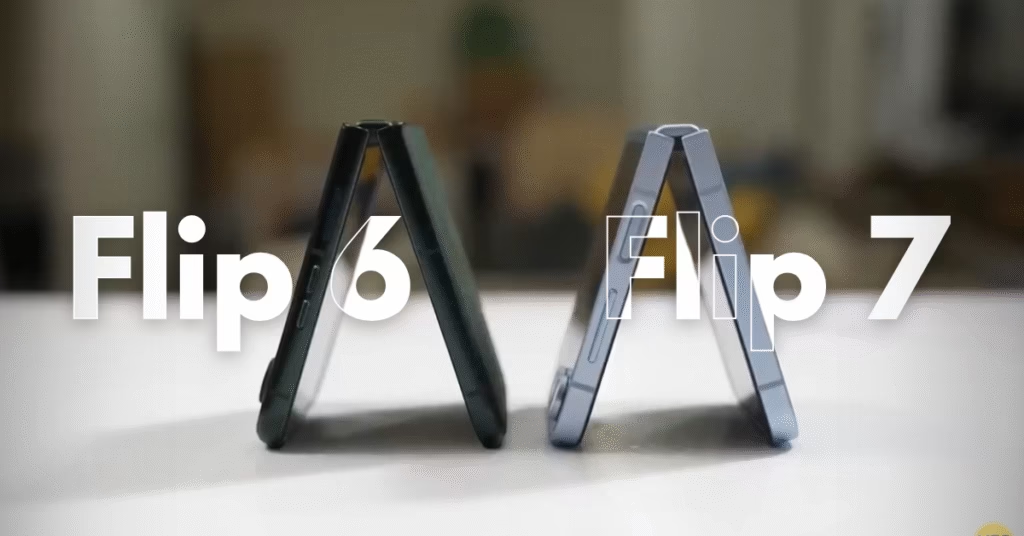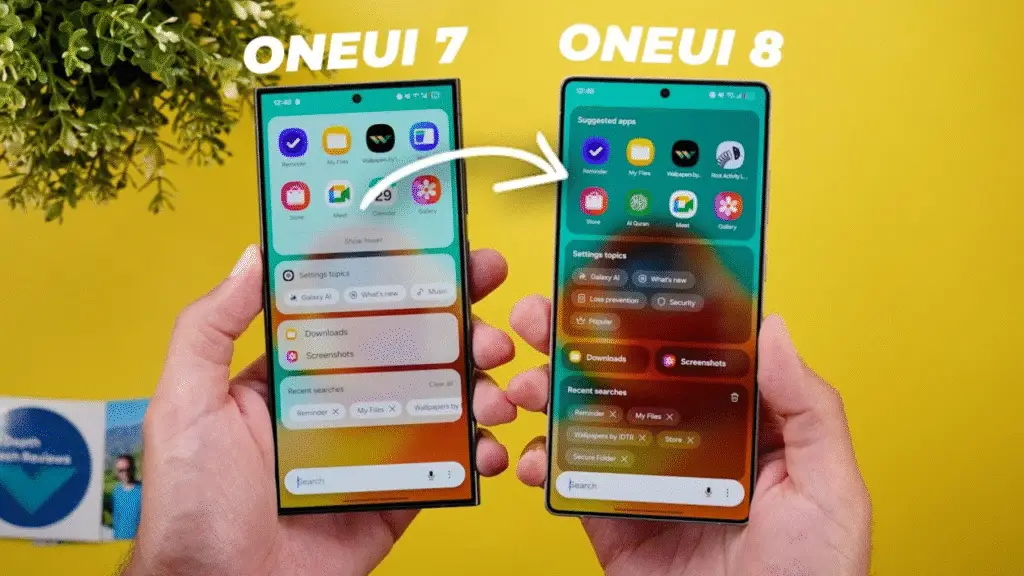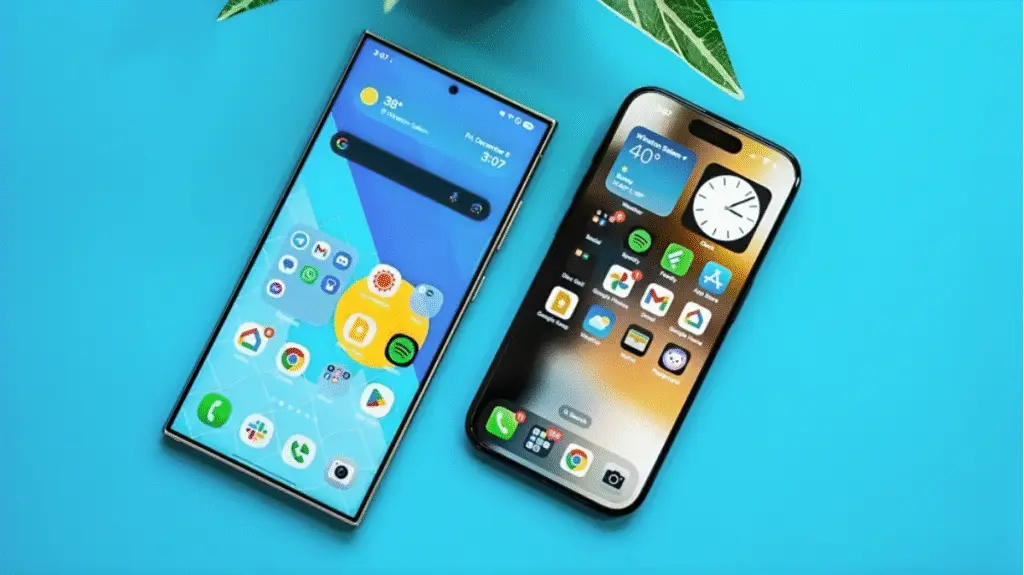
After spending a few weeks switching between the Galaxy Z Flip 7 and the Z Flip 6, I can confidently say Samsung has finally found its rhythm in the foldable game. What once felt like a series of cautious upgrades now feels like genuine egress. The new Flip doesn’t just tweak a few specs it fixes the things that actually matter in day-to-day use.
Design and Build: Familiar Yet Fresh
At first glance, the Z Flip 7 looks noticeably cleaner than the model before it. Samsung has refined the shape, trimmed the bezels, and stretched the frame slightly to make room for a bigger outer display. The old folder-style cover screen is gone, replaced by a full-size panel that finally makes sense for a phone in 2025.
I carried both phones for a few days and the difference is obvious. The Z Flip 6 felt solid but a bit recycled from the Flip 5 era boxier edges, thicker frame, same hinge feel. The newer version looks more elegant and modern. The hinge is tighter and smoother, giving that satisfying click every time you fold it shut.
More importantly, Samsung is rumored to have added dust resistance this year, something Flip owners have been asking for forever. I can’t confirm the official IP rating yet, but the hinge feels better sealed and more durable overall.
Quick Table
| Specification | Galaxy Z Flip 7 | Galaxy Z Flip 6 |
|---|---|---|
| Cover Display | 4.1″ Super AMOLED, 120Hz | 3.4″ Super AMOLED, 60Hz |
| Main Display | 6.9″LTPO AMOLED 2X, thinner bezels | 6.7″LTPO AMOLED 2X |
| Chipset | Exynos 2500 (3 nm) | Snapdragon 8 Gen 3 (4 nm) |
| RAM / Storage | 12GB / 256GB – 512GB | 12GB / 256GB – 512GB |
| Main Camera | 50MP (wide) + 12MP (ultrawide) | 50MP (wide) + 12MP (ultrawide) |
| Front Camera | 10MP | 10MP |
| Battery | 4,300mAh, 25W fast charging | 4,000mAh, 25W fast charging |
| Hinge & Durability | New hinge, IP48 dust and water resistant | Standard hinge, IP48 dust and water resistant |
| Software | One UI 8 (Android 16) + new AI | One UI 6.1 (Android 14) + Galaxy AI |
| Build Material | Gorilla Glass Victus 2, stronger UTG | Gorilla Glass Victus 2, UTG |
Disclaimer: Specs and details are based on leaks and may vary by region. Always verify with official Samsung sources.
Display: A Real Step Forward
The outer display is where the transformation truly shows. Last year’s model had a 3.4-inch cover screen that felt cramped. The latest Flip jumps to 4 inches, and that one-inch difference changes everything. You can finally reply to messages, check notifications, and even run apps comfortably without opening the phone.
The panel looks crisp, smooth, and bright though Samsung hasn’t confirmed whether it supports a 120 Hz refresh rate. Even at 60 Hz, it feels faster thanks to mixed animations. On the inside, you still get a 6.8-inch Dynamic AMOLED 2X display, slightly larger than before and with thinner bezels. Watching videos or scrolling through photos feels more immersive.
The crease in the middle is less visible now. Samsung’s new ultra-thin glass layer makes it smoother to the touch and gives it a sturdier feel when typing or swiping across the center.
Durability: Built to Last
Last year’s Z Flip 6 introduced a thicker ultra-thin glass that made the screen more resistant to scratches. This time, the company moved it even further. The Z Flip 7’s inner display feels firmer, and the fold is less pronounced.
On the outside, Gorilla Glass Victus 2 still traces the body, while the hinge feels more refined. The combination of better materials and that rumored dust resistance gives more confidence that this phone can handle real-world use, something earlier flips always struggled with.
Battery and Charging: Bigger and Better
Battery life is finally catching up to what a flagship should deliver. The older phone had a 4,000 mAh cell, which was decent but not great. The new one packs 4,300 mAh, a noticeable improvement. I consistently got through a full day with heavy use, including camera tests and lots of app usage on the cover screen.
The only disappointment is charging. Samsung still limits it to 25 W, even though many mid-range phones now support 45 W. It takes around an hour and a half for a full charge, which is okay but not impressive. On the bright side, the phone stays cooler during charging thanks to a larger vapor chamber that helps manage heat better than before.
Performance: A Mixed Story
This part surprised me. While last year’s Z Flip 6 ran on the Snapdragon 8 Gen 3 for Galaxy, one of the fastest chips around, the new Flip reportedly ships with the Exynos 2500 in some markets. On paper, that might sound like a downgrade.
In real use, though, the phone performs just fine. Apps open quickly, multitasking feels smooth, and animations are fluid. However, during longer gaming sessions, I noticed slightly higher temperatures compared to the Snapdragon version. For everyday use, most people won’t feel the difference, but power users might prefer the Snapdragon model if available in their region.
Storage options remain the same 256 GB and 512 GB with no 1 TB variant yet.
Camera: Familiar Hardware, Smarter Software
The camera setup hasn’t changed much. You still get a 50 MP main sensor and a 12 MP ultra-wide lens. There’s no telephoto camera, which would have made a big difference. That said, photo quality has moved due to smarter AI cessing and better low-light tuning.
Night photos look cleaner, with more accurate colors and less noise. Daylight shots remain sharp and vibrant. The biggest upgrade is video: the Z Flip 7 handles stabilization better and manages dynamic range more naturally.
While it’s disappointing not to see new sensors, the software movements make the camera experience feel refreshed.
AI and Software: Samsung’s Quiet Advantage
Galaxy AI made its debut on the Z Flip 6, and this year it’s even more integrated. With One UI 8 based on Android 16, Samsung is adding smarter tools like instant voice translation during calls, live meeting transcriptions, and improved photo editing features.
The standout addition is enhanced video AI, the ability to brighten nighttime clips and upscale older videos automatically. These small details make a real difference in daily use, especially if you rely on your phone for quick content creation or travel vlogs.
Even routine tasks, such as summarizing text or generating wallpapers, feel more seamless now. It’s clear Samsung isn’t treating AI as a buzzword anymore; it’s becoming part of how the phone actually works.
Price and Value: What to Expect
The Z Flip 6 saw a small price jump last year, mainly due to better materials and battery upgrades. With all the movements packed into the 7 larger display, stronger hinge, more AI features, and improved durability it’s likely Samsung will stick close to last year’s pricing tier.
Some regions might see a small increase due to tariffs, but Samsung’s pre-order deals usually soften the blow. Trade-in offers, free storage upgrades, or accessory bundles are common and worth waiting for if you’re planning to buy one.
Should You Upgrade?
After living with both devices, here’s the honest take: if you already own the Z Flip 6, the new model feels more like a refinement than a revolution. The bigger cover screen, improved hinge, and better battery life are all meaningful upgrades, but maybe not essential for everyone.
However, if you’re coming from the Z Flip 5 or older, this is a completely different experience. It finally feels like Samsung’s flip phone has grown up. You get a more practical cover screen, longer battery life, better software, and a cleaner design all without losing that signature foldable charm.
For most users, the 7 is the first version that truly balances style, performance, and usability in a compact foldable. It’s no longer about showing off a folding phone; it’s about owning one that actually works well in everyday life.
Final Thoughts
Samsung’s latest flip vest the company isn’t just chasing trends anymore. The Z Flip 7 brings real changes where they count: display, hinge, battery, and AI integration. Even with the same camera hardware and limited charging speed, it’s still the most polished Flip yet.
In a market once dominated by Motorola’s RAZR Ultra, Samsung finally caught up and in some areas, pulled ahead. If you’ve been waiting for a foldable that feels complete, this is it.
See Also Samsung Galaxy S22 vs S25: Which Samsung Should You Buy in 2025?
FAQs (Z Flip 7 vs Z Flip 6)
Is the Z Flip 7 worth upgrading from the Z Flip 6?
If you already own the Z Flip 6, the upgrades are subtle but meaningful. The bigger cover screen, better hinge, improved battery life, and new AI tools make it a smoother experience. For Z Flip 5 or older users, the jump feels major and absolutely worth it.
Does the Z Flip 7 have a bigger battery than the Z Flip 6?
Yes, the Z Flip 7 comes with a 4,300 mAh battery compared to the 4,000 mAh on the Z Flip 6. The difference might look small on paper, but it translates to noticeably longer screen-on time in daily use.
Did Samsung finally add dust resistance to the Z Flip 7?
While not officially confirmed yet, the hinge feels tighter and more sealed than before. Reports suggest Samsung may finally add dust resistance to this model, making it the most durable Flip yet.
What chipset powers the Z Flip 7?
The Z Flip 7 is expected to use the Exynos 2500 in most regions, while some markets might still get the Snapdragon version. Both perform well for everyday tasks, though Snapdragon handles gaming and heat better.
Are there any camera improvements in the Z Flip 7?
Hardware-wise, it’s the same 50 MP main and 12 MP ultra-wide setup as last year. But thanks to new AI processing, photo and video results look cleaner, brighter, and more balanced, especially in low light.



